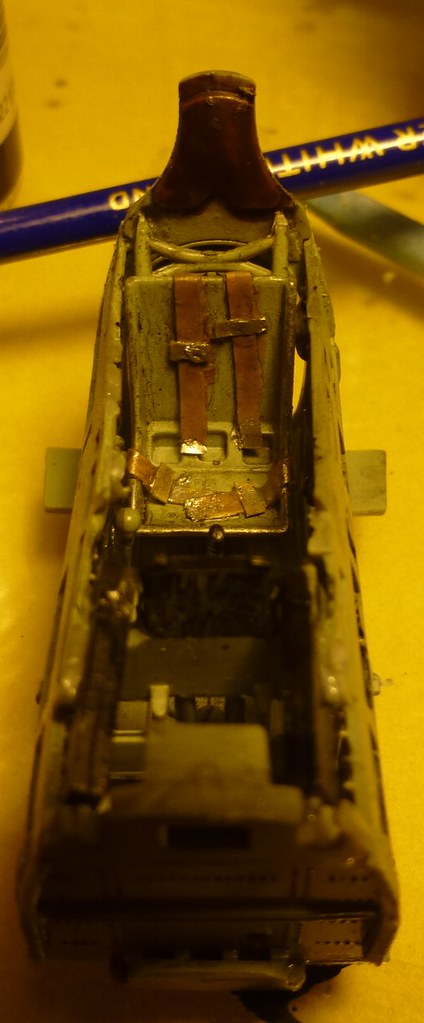MC: good luck on the Swordfish. I've heard that you're building one of the Tamiya's greatest kits (right up there with the Storch) - that should mean a fun build.
Progress report on the Airfix Tomahawk.
First, I finished the cockpit and because everybody shows cockpit pics, I will too. You'll note it's not very detailed - that's because cockpits don't torque my cookies at all. I admire modelers that will work hard on detail that only they and the camera will see, but I'm not one of them. You'll just have to trust me that the instrument panel looked fine after a drybrush. As you can see it's pretty complex - and the cage guarantees that most of it will be invisible. However, even I do seat belts. I'm always on the look-out for a simple scratch belt and I think I'm pretty close to a good one courtesy of a gent on YTube. I took some aluminum foil and covered it on both sides with 6mm Tamiya tape, then cut it into very thin strips and painted it with khaki. Next time I'll do the metal parts thinner, but I think it looks fine. I'll try to remember to take a photo of the interior color from underneath the plane. Suffice it to say, Curtis painted RAF Tomahawks at their factory. The interior green is a pretty light green-gray: much less eye-catching than normal RAF interior green, and lacking the yellow oxide tinge found in US interior green. I have a sample of the Dupont paints used by Curtis and I think the Dark Earth and Middlestone look very close to the RAF original. (I have a file from uber-color guru Nick Milman on RAF colors. He moderates the very neat list Aviation of Japan and has several IJ aircraft books under his belt.)
 cockpit by Eric Bergerud, on Flickr
cockpit by Eric Bergerud, on Flickr
General impressions of the kit so far. This is important because I have six other kits from "new" Airfix in the stash. There is bad news and good news. The bad news is that although the engineering is excellent (it reminds me a lot of the new 1/48 Tamiya Ki-61 and BF-109G which I own) the kit is not made by Tamiya. I like the soft plastic, But there are several irritating sink marks. Airfix uses overly thick connections of all parts to the sprue gates. (I'm very glad that I own good Tamiya sprue cutters and a pair of God Hand single blade nippers. So far it has prevented any part damage and because both cut so close to the part, it cuts sanding time a lot.) There is a lot of very subtle flash, but enough to mean that most parts do need preparation - that slows me down and the part count on this kit is well over 100 parts. Here's a pic of the instructions - it will give you an idea of how complicated the build sequence is - thankfully the instructions are pretty good:
 Instruct by Eric Bergerud, on Flickr
Instruct by Eric Bergerud, on Flickr
Just to give you an idea of what difference exists between the Airfix "pretty good" and the Tamiya "shake and bake", I learned a lot about seams. Despite all of the components inside the fuselage, the two halves fit together nicely. I'm thinking: sweet - almost no filler. On a second look it was obvious that one half was just an iota larger than the other (way less than a mm) - but it caused a seam. So I'm thinking about putty or something else. Luckily I got out my high power modeling glasses and checked the think out closely. Usually one thinks that a seam results because the two parts don't join quite right and there's a gap. In this case, I had a very slight overlap. Had I tried to use putty, it would have been difficult. Instead, I found out that after sanding the "proud" side the fit became just fine and no filler. (Heaven knows how often I've made that mistake in the past. Had I noticed it earlier I could have simply sanded down the larger half just a bit and had a very good fit.)
So that's the good news. If you stick to the basics the kit appears to be pretty good indeed. You have to prep the parts; dry-fit; look at where the tabs are to orient on the parts (not always clear from the instruction) and in general be careful, you're in good shape. On a bad kit, you could do all of those things and there would still be major fit problems requiring major surgery. Knock on wood, but so far things are working - even if it's taking longer than I hoped. Below is the fuselage (actually nearly half done with the kit) - I'm reasonably sure that any irregularities will disaper under my Duplicolor automobile black lacquer rattle can. Need that regardless because this plane begs for black basing.
 fuselage1 by Eric Bergerud, on Flickr
fuselage1 by Eric Bergerud, on Flickr
BTW: if anyone is curious there's a very fine US rendition of the Airfix P-40B on iModeler. I hope that not all of the warnings there will be true, but nothing too bad. The weathering is absolutely splendid rendition of black basing with standard USAAF oliver drab/gray.
http://imodeler.com/2017/03/airfix-148th-p-40b-warhawk-build-review-part-2/
Eric